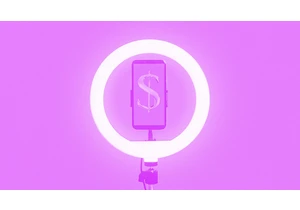Journalist Kaitlyn Tiffany was 19 when she first watched 1D: This is Us, a documentary about the British boy band One Direction. Tiffany came away from the viewing unimpressed; the five boys were kind of boring, she thought, and every song sounded the same.
Yet just a few months later, there she was belting out the lyrics to “ " target="_blank" rel="noopener noreferrer">Story of My Life” as if the world depended on it. Tiffany took to One Direction’s online subculture because she found a community that, like her, reveled in supporting their favorite artists. Over time, Tiffany came to look at these spaces as a reporter rather than a participant, asking how and why fans flock to the internet.
“In the early days of social media, women made up a bigger proportion of Twitter users and Tumblr users,” Tiffany tells Fast Company. “And I think fandom is just sort of an obvious way to use those sites.”
We talked with Tiffany, now a staff writer at The Atlantic, about her new book, Everything I Need I Get From You: How Fangirls Created the Internet as We Know It, and why she believes online fandoms created today’s internet culture.
The interview has been edited for length and clarity.
You talk in the book about discovering One Direction in college and, soon after, joining this online community of die-hard fans. How did that interest lead you to write a book?
There’s obviously a lot of really great academic work about fandom, especially in long form—book form—but I didn’t feel like there was a kind of mainstream, popular press explanation of just how much the story of fandom and the story of social media and the internet were really intertwined. I was working on the proposal and pitching the book in 2019, so I feel like there was a lot of conversation at that time about the way we live online.
Fandom is the air you breathe on the internet, even if you aren’t engaging. It’s still kind of the emotional balance of Twitter, it’s still the way people respond whereby fanning or anti-fanning to political events, news events, cultural phenomena. And One Direction was a way to go about doing that because fandom as a topic in general would have been way too broad.
Despite what people might assume, your book isn’t really about One Direction, or even Twitter and Tumbler for that matter. If you could boil it down, how should we think about the connection between a boy-band obsession and the power of the fangirl online?
There’s a reason that whenever a new internet technology is created, the first people who are going to gravitate to that platform are the people who have a hard time expressing themselves offline, or there’s not a good way to do what they want to do offline. That’s why the porn industry is an early adopter of the internet. That’s also why right-wing extremists have always been very good at using the internet.
But less darkly, that’s also why fans are really good at using the internet and have always been drawn to the internet and exhibit a creator’s hand in helping platforms grow and develop new features because they are the most avid users of these platforms. There isn’t a really great way to exhibit fandom offline beyond obviously attending a concert, which, especially in the case of One Direction, is not possible all the time or at all anymore.

I think the word fan is used by brands now to mean anybody who buys something or buys into something or expresses any kind of a need for anything, which is kind of frustrating. You see fan-related brands like Ticketmaster really deliberately co-opting the language of fandom in order to market things to fans and get more money out of them. Which is, I think, part of the reason that fans sort of can report and wriggle away from that sort of language and will start to call themselves weirder stuff, like “One Direction Trash.”
You also write in your book about the importance of cultural memory. Yet sites like Tumblr are notoriously bad at archiving material. In that sense, are fandoms delicate? Is there a risk that, down the line, fans’ work and dedication will be lost?
Fandoms are actually a little more stable than some of the other uses of the internet or other types of internet history because there is that impulse that fans have to constantly be self-archiving or self-historicizing. There’s sort of an oral tradition in fandom, reciting “Remember when?” back to each other. Who remembers this weird meme? Who remembers the time that we stole airport security footage to see Harry Styles in the Australian airport? Just in talking about these things, they’re archiving them, which is sort of a point that I tried to make in the book when I was going to look for the shrine to Harry Styles’s vomit.
You bring up two major One Direction conspiracy theories in your book commonly known as “Larry Stylinson” and “Babygate,” both of which posit that Harry Styles and Louis Tomlinson are secretly in love. It was interesting to read how you compared the depth of belief in these theories with, say, QAnon followers. Should we be concerned?
It would be irresponsible to say that it’s the same thing as QAnon in the sense that the people who believe in Babygate are not committing violence. They are not actively trying to recruit thousands or millions of other Americans, they kind of just want to be left alone.
There is a spectrum of how substantial these conspiracy theories are. Obviously, the Amber Heard and Johnny Depp trial showed how far a fandom conspiracy theory can go in affecting the popular discourse around a fan object or a based conspiracy theory. I think that was pretty alarming.

Once you get past the stereotype of what a One Direction fan was, which was a white, heterosexual teenage American or British girl, you start to think about all the other groups of people who are part of the One Direction fandom and who were asking to be seen within that fandom. I specifically touch on the LGBTQ community because they were really organized with the project “Rainbow Direction.” That project had visibility within fandom as its goal.
And then I also talk quite a bit about Black Harry Styles fans who call themselves “Black Harries” and their efforts to get him to participate in Black Lives Matter and to acknowledge their presence within fandom, and to push back against white fans who were very territorial about their own space within the fandom.
I think we’ll see more of that and more of different fandoms sort of asking to be seen as something other than a monolith. Currently, American popular press will refer to K-pop fans as one group, which certainly is not accurate [and it’s] not very helpful for understanding fandom to just say “all the Gen Z K-pop fans.” I think we’ll hopefully see people speaking in more specific ways about the people who participate in fandom.
Your book traces the common phenomena of screaming fangirls through music history. From The Beatles to Justin Bieber, and now One Direction, shrieking fans are a given. At the same time, this has contributed to the fangirl’s reputation as delusional. What have you learned about the cultural significance of the screaming fangirl?
This trope of the screaming fan is obviously not an inaccurate one—like I’ve been to One Direction concerts where you can’t hear the music because everyone’s just yelling.
In historical fandom, there was an expectation of silence for girls and women most of the time. And even now, there are so few situations in modern life where you are allowed to be out of control in that way. And I think people pursue that feeling of surrendering control in a lot of ways.
Connectez-vous pour ajouter un commentaire
Autres messages de ce groupe

Yahoo’s bet on creator-led content appears to be paying off. Yahoo Creators, the media company’s publishing platform for creators, had its most lucrative month yet in June.
Launched in M

From being the face of memestock mania to going viral for inadvertently stapling the screens of brand-new video game consoles, GameStop is no stranger to infamy.
Last month, during the m

The technology industry has always adored its improbably audacious goals and their associated buzzwords. Meta CEO Mark Zuckerberg is among the most enamored. After all, the name “Meta” is the resi

Even as AI becomes a common workplace tool, its use in

Finding a job is hard right now. To cope, Gen Zers are documenting the reality of unemployment in 2025.
“You look sadder,” one TikTok po

Hiding your address, phone number, and other details is easier than you might think.
